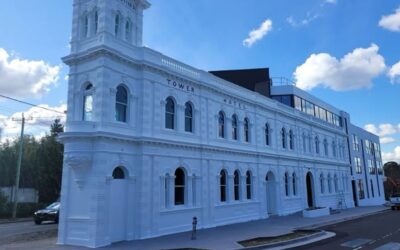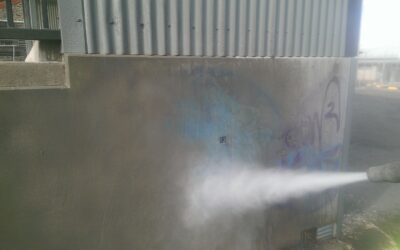When did you last give your commercial building a fresh coat of paint? If you’re scratching your head, you’re not alone. Painting commercial buildings is often overlooked in property maintenance, yet it plays a crucial role in preserving aesthetic appeal and structural integrity. Whether you own an office space, warehouse, or retail store, knowing when to repaint your property is vital to maintaining its value and functionality.
This comprehensive guide will explore the factors influencing how often different commercial properties should be repainted. We’ll cover everything from wear and tear to climate considerations and brand updates. And if you’re looking for professional help, Melbourne-based Quinns Painting & Decorating is just a call away, on (03) 8804 5840.
Understanding the Importance of Commercial Building Painting
Painting isn’t just about aesthetics; it’s an essential aspect of property maintenance. A well-maintained exterior can make a positive impression on clients and customers, while a neglected one can turn them away. Furthermore, paint is a protective barrier against environmental factors that can cause long-term damage.
A fresh coat of paint can also boost employee morale. Imagine working in a vibrant, well-maintained office rather than a dull, peeling one. Similarly, a visually appealing facade for retail stores can attract more foot traffic, increasing sales opportunities. In warehouses, durable paint can protect walls and surfaces from the wear and tear of daily operations.
Factors Influencing Repainting Frequency
Several factors determine how often your commercial building should be repainted. Understanding these can help you plan and budget effectively for your painting needs.
Wear and Tear
The amount of wear and tear a building experiences significantly impacts how often it should be repainted. High-traffic areas such as entrances and hallways show signs of wear faster than less frequented ones. In retail, frequent customer interaction can lead to scuffs, scratches, and general deterioration of wall surfaces.
Moving goods, machinery, and warehouse equipment can damage walls and floors. Regular inspections can help identify areas that need attention, allowing you to address issues before they escalate into costly repairs.
Climate Considerations
Climate plays a vital role in the longevity of your building’s paint job. Paint can deteriorate more rapidly in areas with harsh weather conditions, such as extreme heat or heavy rainfall. Melbourne, for instance, experiences a diverse climate, with hot summers and cold, wet winters. These fluctuations can cause paint to crack and peel.
Consider using high-quality, weather-resistant paints designed to withstand the elements to combat this. Quinns Painting offers expert advice on the best paint choices for different climates, ensuring your property remains protected year-round.
Brand Updates
In today’s competitive business landscape, branding is everything. A fresh coat of paint can help align your building’s appearance with your brand identity. If your company undergoes a rebranding or updates its colour scheme, repainting your property is necessary.
Consistent branding across all touchpoints, including physical locations, helps reinforce brand recognition and trust among clients and customers. Whether launching a new logo or updating your brand colours, painting effectively reflects these changes.
Repainting Guidelines for Different Commercial Properties
Now that we’ve covered the factors influencing repainting frequency let’s explore specific guidelines for various commercial properties.
Office Buildings
Office buildings typically require repainting every 3 to 5 years. However, high-traffic areas like lobbies, conference rooms, and corridors may need more frequent attention. Regular maintenance checks can help identify areas needing a refresh, allowing you to plan repainting projects accordingly.
Retail Stores
Retail environments demand a higher standard of visual appeal to attract and retain customers. To maintain a fresh and inviting atmosphere, consider repainting every 2 to 3 years. Pay special attention to storefronts, display areas, and fitting rooms, as these are the spaces that customers interact with the most.
Warehouses
Warehouses require durable paint solutions that can withstand the rigors of daily operations. While the exterior of a warehouse may need repainting every 5 to 7 years, interior spaces subjected to heavy use and exposure to machinery may require more frequent touch-ups. Regular inspections can help identify areas where paint has worn off, ensuring your warehouse remains functional and safe for employees.
Restaurants and Cafes
In the food service industry, cleanliness and aesthetics are paramount. To maintain a welcoming environment for patrons, restaurants and cafes should be repainted every 3 to 4 years. Dining areas, kitchens, and restrooms should be prioritized for repainting, as these spaces see high traffic and can quickly show signs of wear.
Hospitals and Healthcare Facilities
Healthcare facilities have unique requirements when it comes to painting. Hygiene and safety are top priorities, making regular repainting essential. Consider repainting every 3 to 5 years, focusing on waiting areas, patient rooms, and corridors. Low-VOC (volatile organic compounds) paints ensure a healthy indoor environment for patients and staff.
Choosing the Right Paint for Commercial Buildings
Consider durability, colour, and finish factors when selecting paint for commercial properties. High-quality paints with excellent coverage and fading resistance are ideal for interiors and exteriors.
For interiors, choose colours that align with your brand and create a pleasant atmosphere for employees and customers. Matte and satin finishes work well for offices and retail spaces, while semi-gloss and gloss finishes suit high-moisture areas like kitchens and bathrooms.
Exteriors require weather-resistant paints that can withstand environmental conditions. Neutral tones and earth colors are famous for commercial buildings, conveying professionalism and timelessness.
The Role of Professional Painters
While some property owners may attempt DIY painting projects, hiring professional painters offers several advantages. Experienced painters have the knowledge, skills, and tools to deliver high-quality results efficiently and safely.
Professional painters can assess the condition of your building, recommend the best paint products, and execute the project with minimal disruption to your operations. They can also provide valuable insights into colour selection and design trends to enhance your property’s appeal.
Based in Melbourne, Quinns Painting is a trusted name in commercial painting. With over a decade of experience, our team of qualified painters is committed to delivering superior craftsmanship and customer satisfaction.
Planning and Budgeting for Repainting Projects
Careful planning and budgeting are essential to a successful repainting project. Start by assessing the current condition of your building’s paintwork. Identify areas that require immediate attention and prioritise them in your repainting schedule.
Consider factors such as the size of your property, the complexity of the project, and the type of paint required when estimating expenses.
It’s also important to budget for ongoing maintenance and touch-ups to extend the life of your paint job. Regular inspections and minor repairs can prevent costly repainting projects in the long run.
Conclusion
Repainting commercial buildings is a vital aspect of property maintenance that should not be overlooked. By understanding the factors influencing repainting frequency and following the guidelines outlined in this guide, you can keep your property looking its best while protecting its value.
Whether you own an office, retail store, or warehouse, regular painting ensures a positive impression, enhances employee morale, and reinforces your brand identity. For professional painting services in Melbourne, consider Quinns Painting for expert advice and top-quality workmanship. Call today on (03) 8804 5840 or visit our contact page.
Stay proactive in maintaining your commercial property, and enjoy the benefits of a well-painted, visually appealing building that stands the test of time.



